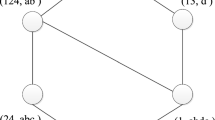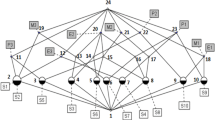Abstract
Concept lattice is an area of research which is based on a set-theoretical model for concepts and conceptual hierarchies. It is better for the studying of concept lattice to minimize the input data before revealing the construction of a concept lattice. Actually, this duty can be done by attribute reduction for a context. Graph is useful in data analysis since it gives us a visual trend on the behavior of our data points and allows us to test some laws in data analysis. This paper is a preliminary attempt to study how directed graph can be used on attribute reduction and conceptual construction in concept lattices. We investigate all the reducible attributes and concepts in a context with the aid of graph theory. For a context, we define a relevant graph on the set of attributes and, further, define a pre-weighted relevant graph. Afterward, using relevant graphs and pre-weighted relevant graphs with the method of deleting vertices in a directed graph, we find all the reducible attributes in a context. After that, we seek out all of concepts and the concept lattice for a given context. All these results may be not only used to improve the visibility and readability of attribute reduction in a context and the construction of concept lattice, but also broaden the applied range of directed graph such as in the field of attribute reduction.









Similar content being viewed by others
References
Abello J, Pogel AJ, Miller L (2004) Breadth first search graph partitions and concept lattices. J. Univers Comput Sci 10(8):934–954
Amilhastre J, Vilarem MC, Janssen P (1998) Complexity of minimum biclique cover and minimum biclique decomposition for bipartite deminofree graphs. Discret Appl Math 86:125–144
Apollonio N, Caramia M, Franciosa PG (2015) On the Galois lattice of bipartite distance hereditary graphs. Discret Appl Math 190–191:13–23
Bělohlǎvek R, Baets BD, Outrata J, Vychodil V (2008) Characterizing trees in concept lattices. Int J Uncertain Fuzz Knowl-Based Syst 16(1):1–15
Berry A, Sigayret A (2004) Representing a concept lattice by a graph. Discret Appl Math 144:27–42
Bondy JA, Murty USR (2008) Graph theory. Springer, San Francisco
Davey BA, Priestley HA (2002) Introduction to lattice and order, 2nd edn. Cambridge University Press, Cambridge
Dias SM, Vieira NJ (2015) Concept lattices reduction: definition, analysis and classification. Expert Syst Appl 42(20):7084–7097
Ganter B, Wille R (1999) Formal concept analysis: mathematical foundations. Springer, Berlin (German version in 1996)
Ghosh P, Kundu K, Sarkar D (2010) Fuzzy graph representation of a fuzzy concept lattice. Fuzzy Sets Syst 161:1669–1675
Mao H (2012) Representing a concept lattice by neighborly ideas. Analele Universitatii de Vest, Timisoara, serial Matematica-Informatica 50(1):77–82
Mao H (2014) A graph-theoretic method to representing a concept lattice. Appl Math Inf Sci 8(2):553–561
Mao H (2014) Characterization and reduction of concept lattices through matroid theory. Inf Sci 28:338–354
Poelmans J, Kuznetsov SO, Ignatov DI, Dedene G (2013) Formal concept analysis in knowledge processing: a survey on applications. Expert Syst Appl 40(16):6538–6560
Singh PK, Kumar CA (2014) Bipolar fuzzy graph representation of concept lattice. Inform Sci 288:437–448
Singh PK, Kumar CA (2016) A comprehensive survey on formal concept analysis, its research trends and applications. Int J Appl Math Comput Sci 26(2):495–516
Škopljanac-Mačina F, Blašković B (2014) Formal concept analysis—overview and applications. Proced Eng 69:1258–1267
Wei L, Wan Q (2016) Granular transformation and irreducible element judgment theory based on pictorial diagrams. IEEE Trans Cybern 46(2):380–387
Wille R (1982) Restructuring lattice theory: an approach based on hierarchies of concepts. In: Rival I (ed) Ordered sets. Reidel, Dordrech, pp 445–470
Wille R (1989) Lattices in data analysis; how to draw them with a computer. In: Rival I (ed) Algorithms and order. Kluwer Academic Publishers, London, pp 33–58
Xu WH, Zhang XY, Zhong JM, Zhang WX (2010) Attribute reduction in ordered information systems based on evidence theory. Knowl Inf Syst 25:169–184
Zhang, T., Li, H., Hong, W.X., Yuan, X., Wei, X.Y.: Deep first formal concept search. The Scientific World Journal, vol.2014, Article ID 275679, 13 pages (2014)
Zhang WX, Wei L, Qi JJ (2005) Attribute reduction theory and approach to concept lattice. Science in China Ser. F. Inf Sci 48(6):712–726
Acknowledgements
The author sincerely acknowledges the financial support from the Natural Science Foundation of China (61572011) and Natural Science Foundation of Hebei Province (A2013201119).
Author information
Authors and Affiliations
Corresponding author
Ethics declarations
Conflict of interest
The authors declare that there is no conflict of interest regarding the publication of this paper.
Additional information
Communicated by A. Di Nola.
Rights and permissions
About this article
Cite this article
Mao, H. Representing attribute reduction and concepts in concept lattice using graphs. Soft Comput 21, 7293–7311 (2017). https://doi.org/10.1007/s00500-016-2441-2
Published:
Issue Date:
DOI: https://doi.org/10.1007/s00500-016-2441-2




